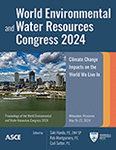Analyzing Drought Hazards under a Changing Climate for the Semi-Arid Central Gujarat Region, India
Publication: World Environmental and Water Resources Congress 2024
ABSTRACT
Present research is focused on assessing spatiotemporal variability of meteorological drought based on Standardized Precipitation Index (SPI), non-parametric trend tests, and identifying drought hazardous pockets in semi-arid central Gujarat region, India. The SPI method at six monthly time step indicating seasonal drought has been utilized to characterize peak drought events, duration, occurrence probability, and major drought years. The SPI-6 time series has been further analyzed with Mann-Kendall (MK) and Sen’s slope (SEN) tests to understand significance and magnitude of trends. The monthly rainfall data were obtained from Indian Meteorological Department (IMD) gridded data archive having 0.25° resolution for the time period of 1951−2020. The study revealed major droughts occurred in 1951, 1968, 1972, 1974, 1987, 1991, 2002, and 2015. The IDW interpolation method in GIS-Environment was adopted for spatial distribution of major drought years, near to extreme drought categories, as well as trend analysis outcomes. Based on the average SPI-6 values, 1985−1987, 1991−1993, and 1999−2002 durations were observed to be crucial drought scenarios in which the year 1987 was most extreme with drought intensity up to −2.86 in the northwest pockets. The reclassify and weighted sum operations were employed on the raster maps of drought occurrence probability (%) and trend magnitude (SEN) of drought series to prepare drought hazard map (DHI). The central Gujarat region observed 30.45% and 10.48% area under severe and extreme hazards. The outcomes from current research will prove helpful in evaluating regional drought policies for sustainable management of water resources under a changing climate.
Get full access to this chapter
View all available purchase options and get full access to this chapter.
REFERENCES
Bandyopadhyay, N., and Saha, A. K. A comparative analysis of four drought indices using geospatial data in Gujarat, India. Arab J Geosci 9, 341 (2016). https://doi.org/10.1007/s12517-016-2378-x.
Cook, B. I., Mankin, J. S., and Anchukaitis, K. J. Climate Change and Drought: From Past to Future. Current Climate Change Reports, 4, 164–179 (2018). https://doi.org/10.1007/s40641-018-0093-2.
Das, J., Gayen, A., and Saha, P. Meteorological drought analysis using Standardized Precipitation Index over Luni River Basin in Rajasthan, India. SN Appl. Sci. 2, 1530 (2020). https://doi.org/10.1007/s42452-020-03321-w.
Joshi, G. S., and Shah, S. 2022. Trend analysis of hydro-meteorological parameters and influence of anthropogenic activities in lower Narmada river basin, India. Physics and Chemistry of the Earth, Parts a/b/c, 126, 103148. https://doi.org/10.1016/j.pce.2022.103148.
Kendall. 1975. Rank Correlation Methods. Charless Griffin, London.
Kim, H., et al. Assessment of drought hazard, vulnerability, and risk: A case study for administrative districts in South Korea, Journal of Hydro-environment Research (2013), https://doi.org/10.1016/j.jher.2013.07.003.
Mann. 1945. Nonparametric tests against trend. Econometrica 13, 245–259.
McKee. 1993. The relationship of drought frequency and duration to time scales, 8th Conference on Applied Climatology, Anaheim, California, 17–22 January, pp.179–184.
MDM. 2009. Manual for Drought Management, November 2009.
Mukherjee, S., Mishra, A. K., and Trenberth, K. E. 2018. Climate Change and Drought: a Perspective on Drought Indices. Current Climate Change Reports, 4, 145–163. https://doi.org/10.1007/s40641-018-0098-x.
Pai, D. S., Sridhar, L., and Guhathakurta, P. District-wide drought climatology of the southwest monsoon season over India based on standardized precipitation index (SPI). Nat Hazards 59, 1797–1813 (2011). https://doi.org/10.1007/s11069-011-9867-8.
Patel, N. R., Chopra, P., and Dadhwal, V. K. 2007. Analyzing spatial patterns of meteorological drought using standardized precipitation index. Met. Apps, 14: 329–336. https://doi.org/10.1002/met.33.
PMKSY. 2020. District Irrigation Plan (2016-2020) of Ahmedabad, Kheda and Anand districts, Reports of PMKSY (Predhan Mantri Krishi Sinchayee Yojana) prepared by NABCONS.
Sen. 1968. Estimates of the regression coefficient based on Kendall’s tau. J.Am.Stat.Asc.,63.
Sekharan, N., Kurian, M., and Jawahar Saud, S. 2022. Drought Intensity Mapping of Kannur District, Kerala, India. In: Marano, G.C., Ray Chaudhuri, S., Unni Kartha, G., Kavitha, P.E., Prasad, R., Achison, R.J. (eds) Proceedings of SECON’21. SECON 2021. Lecture Notes in Civil Engineering, vol 171. Springer, Cham. https://doi.org/10.1007/978-3-030-80312-4_54.
Sönmez, F. K., Kömüscü, A. Ü., and Erkan, A. An Analysis of Spatial and Temporal Dimension of Drought Vulnerability in Turkey Using the Standardized Precipitation Index. Nat Hazards 35, 243–264 (2005). https://doi.org/10.1007/s11069-004-5704-7.
WMO. 2012. Standardized Precipitation Index User Guide, Report of World Meteorological Organization (M. Svoboda, M. Hayes and D. Wood), Geneva, ISBN 978-92-63-11091-6.
Information & Authors
Information
Published In
History
Published online: May 16, 2024
ASCE Technical Topics:
- Arid lands
- Business management
- Climates
- Developing countries
- Disaster risk management
- Disasters and hazards
- Droughts
- Engineering fundamentals
- Environmental engineering
- Irrigation engineering
- Mathematics
- Meteorology
- Natural disasters
- Practice and Profession
- Probability
- Water and water resources
- Water management
- Water shortage
- Water supply
Authors
Metrics & Citations
Metrics
Citations
Download citation
If you have the appropriate software installed, you can download article citation data to the citation manager of your choice. Simply select your manager software from the list below and click Download.
